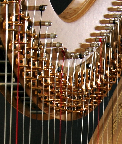Eurhythmics Teaching
Eurhythmics is a movement-based form of rhythmic and musical education. Dr. Ellis trained in Eurhythmics under Brian Sweigart during her graduate work at CIM where she took ten eurhythmics courses in two years, including four courses specific to eurhythmics pedagogy, and helped to teach in both the early childhood and collegiate eurhythmics program. She founded a eurhythmics program in Ann Arbor for University of Michigan undergraduate and graduate students that began just with the University of Michigan viola studio expanded to cover instrumentalists and vocalists across five levels; she taught twelve semester-long courses in three years. She has served as guest clinician teaching how to incorporate eurhythmics in the private lesson for the San Francisco Chapter of the American String Teachers Association and for the strings pedagogy class at the San Francisco Conservatory of Music. She has also run workshops on using eurhythmics in classroom teaching for the University of Michigan NafME chapter and the University of Massachusetts, Amherst NafME chapter.
Dr. Ellis is available for eurhythmics private lessons, group classes, and workshops. She offers eurhythmics workshops geared towards honing your internal pulse, improving switching between mixed meters, polishing polyrhythms/crossrhythms, as well as a general eurhythmics introduction. To book, contact her.
**Eurhythmics FAQs**
What is Eurhythmics?
Eurhythmics is a kinesthetic rhythmic education.
Eurhythmics hones listening skills and teaches students to transform what they hear into accurate movements
Eurhythmics develops a sense of pulse and tempo. Studying Eurhythmics helps students become comfortable with the rhythmic complexities of current music.
A Eurhythmics education fosters the connection between what students hear in their heads and what their bodies do to play an instrument and achieve sound.
For young children, Eurhythmics is a play-based form of musical education. While giving children a solid foundation for future musical study, Eurhythmics helps develop ear, timing, and motor skills.
Some people claim you either “have” rhythm or you don’t. Eurhythmics makes rhythm a practicable, learnable skill that any student can develop.
Who Developed Eurhythmics?
Pedagogue Emile Dalcroze developed eurhythmics in late 19th Century Geneva.
Eurhythmics programs have been adopted by institutions such as Cleveland Institute of Music, Longy School of Music, University of Washington, Carnegie Mellon University, as well as numerous community music schools, private schools, and early childhood education programs.
What Activities make up a eurhythmics class? What do students gain?
Early childhood classes introduce musical concepts while children play. These classes teach listening skills, encourage motor development, and lay the foundation for future musical study. Students understand different note values as different sizes of steps and students learn rhythmic and some pitch notation through movement. These courses can be an excellent precursor to private lessons.
Preparatory classes include walking and identifying some basic tempos. This training in perceiving an external tempo and matching it will help students involved with youth orchestras feel more confident with their entrances. Students will learn to hear and identify mixed meters by learning a series of swing patterns with their arms. Eurhythmics will introduce and solidify complex rhythms such as two against three. Also, eurhythmics helps such students maintain the brain-body connection and solidify a sense of internal pulse.
Collegiate classes help music students refine their rhythm as they transition from being music students to music professionals. Students gain confidence, improve their sight-reading skills, and learn to deftly execute cross-rhythms and metric changes. Students hone their sense of tempo and develop their rhythmic vocabulary through hands-on exercises.
Is Eurhythmics a good fit for my institution?
Eurhythmics brings students into the preparatory program from a very young age and they will be more likely to start lessons earlier.
Eurhythmics helps alleviate some of the curricular pressures in the theory department.
Private instructors of students in eurhythmics programs say that they spend more of the lesson talking about the music because they do not have to spend much time on rhythm.
How do I enroll?
Contact Jennifer R. Ellis directly for more information.
